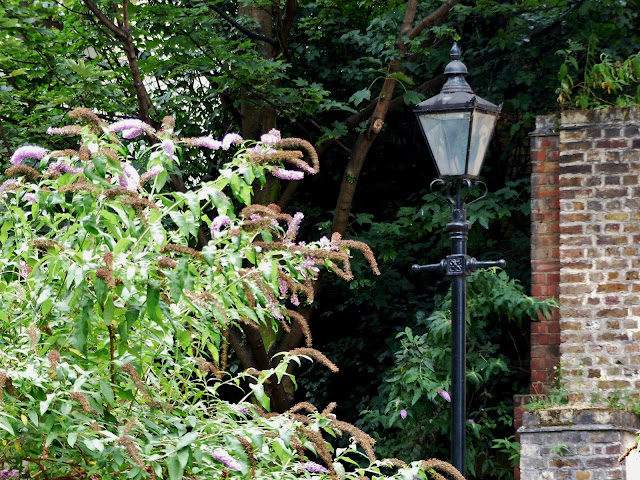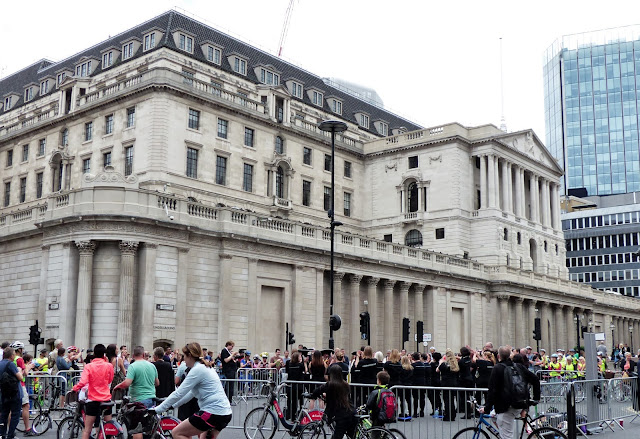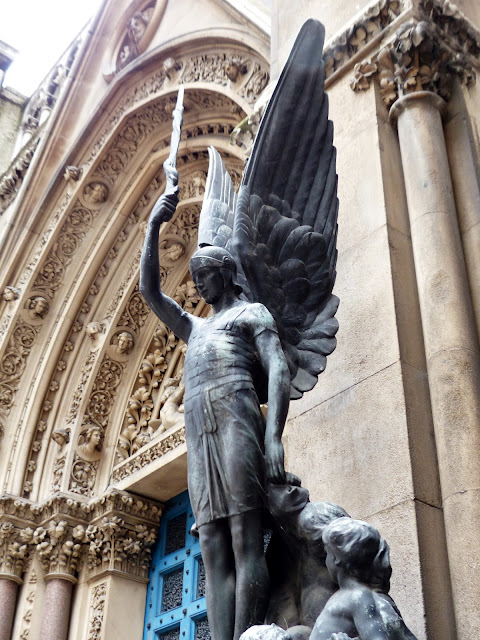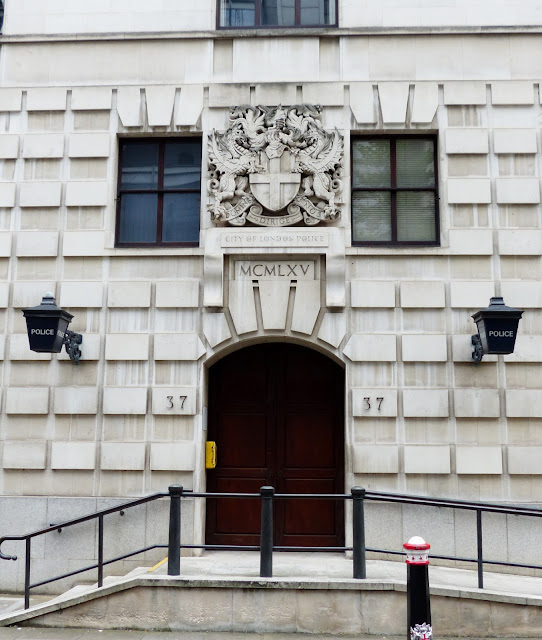In spite of many years of development, fire, redevelopment the Roman wall that once stood around Londinium can still be seen in places, the road called 'London Wall' kind of illustrates it well. Here, just below the 'Museum of London' is one huge part which has as you can see been built upon many times since the Romans began it in the middle of the first century AD.
From the tower that was the wall stretched southwards towards the Thames yet lay hidden for many years until those German Heinkel pilots dropped their bombs upon the then buildings standing here revealing the hidden gems for all to see. Actually there is not much to see at all but the eager archeologists who strove to uncover the foundations and interpret their finds enjoyed greatly what they came upon.
Clearly the Victorian churchmen were not going to allow new constructions to steal a foot of their territory as in between what once were built here stood this sign, dated 1860, for all to see and take note off. The Parish limits must be observed and it is important to ensure the correct people are in charge of appropriate spaces. Anyway rates must be paid to the right hand innit guv.
I took this simply because I liked it. This lamppost stands at the rear of the Gresham Centre, once St Anne & St Anne's Church, and now a centre for 'vocal music performance.' I suppose in days of yore we called that 'singing?
Postman's Park hosts the memorial begun in the 19th century to those who died attempting to save others. A noble enterprise that has not been continued by the tabloid press which is a pity. There are numerous such heroic acts these days but these flash by with no permanent memorial to be found.
Yet another closed church on a Saturday yet clearly open during the week for the million or so City workers passing each other daily as they run the 'rat race.' The 'Postman's Park is what once was the church grounds, the name coming from the nearby Royal Mail headquarters and the many post employees who sit in the park I suppose for lunch. Here the memorial to the dead hero's stands among the remains of the old graveyard. Now well tended and peaceful a welcome break for the city worker.
A break was indeed required so I made for the 'Lord Raglan' the only hostelry open and for the same price as my earlier Egg and bacon roll and coffee I obtained one pint of Guinness. For London I suppose it was cheap! This appeared to be the only pub for miles around, not that I looked, and from the window i watched the passersby pass by.
Tourists and those connected to the never ending cyclists, people leaving the nearby Museum and a wedding party all in their finery heading for the Postman's Park for photographs. Later, much later, a young woman in high heels too high for her wobbled past in that direction and I wished I had the video working at the time. Fashion dictates and the results are not always in the lassies interests.
The Lord Raglan pub stands in St Martins-le-Grand, a continuation of Aldersgate Street. The name comes from the gate in the wall that once stood here, and the name itself possibly from a later Saxon, one 'Ealdred' after the Romans had long gone. Aldersgate Street in in fact the beginning, or the end depending on which way you are travelling, of the A1, the Great North Road. As such this is the gate through which James VI and I arrived in London in 1603 to claim the English throne and rightly place England under Scots control.
During 1738 John Wesley attended a meeting here and while the preacher spoke on the Letter to the Romans John felt his heart 'strangely warmed' and the Methodists had begun. Aldersgate was demolished in 1761 probably while rich folks houses were erected but I doubt John Wesley had anything to do with that.
The 'Lord Raglan' has been here for centuries, Shakespeare is supposed to have visited but he is supposed to have visited most pubs in London at one time, and this one was rebuilt in the mid 19th century and and named after the Crimean War General. The pub retains a welcoming dark wooden Victorian interior. I found the staff efficient even friendly, the place clean and well looked after and the toilets aged in style in keeping with the building but considerably cleaner than mine! Upstairs snooker tables await those willing to show off! I didn't.
Had I been young and rich I would of course travel about on one of these. However I would not park it like this near a narrow road turning in central London! Actually I would never have one of these, the one bike I got I destroyed by technical incompetence and this modern British 'Triumph' would not survive my skills. I wanted a bike when I was 15 and stood outside Alexander's shop in Lothian Road hoping they would give me a spare 'BSA,' 'Triumph,' 'Norton' or even a wee 'James.' They never did and by the time I was 17 they had all been killed off by the Japanese! The British manufacturers refusal to change their ways led to huge sales of the vastly superiour 'Suzuki' and 'Honda's' killing the industry. Man management, planning and unwillingness to change their ways killed them long before Maggie Thatcher was able to do so.
A quick last look again at the smell of the Thames and while the sewage bubbles under and the occasional tourist falls in and drifts off towards the open sea I rest my hot lens and seek refuge in the train before my knees give way.


















































